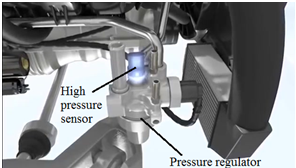Main Article Content
Abstract
Artikel ini menyajikan sebuah review teknologi kendaraan berbahan bakar Compressed Natural Gas (CNG) atau yang dikenal dengan Natural Gas Vehicle (NGV). Metode review yang digunakan adalah dengan membandingkan teknologi Bosch Compressed Natural Gas Powertrain dengan beberapa laporan penelitian yang relevan dari segi output daya mesin, efek lingkungan, dan manfaat secara ekonomi. Hasil studi ini menunjukkan bahwa output daya kendaraan yang dioperasikan dengan CNG lebih rendah daripada yang dioperasikan dengan bensin atau LPG karena efisiensi volumetrik yang rendah. Namun demikian, dari aspek lingkungan dan aspek ekonomi, kendaraan CNG menjanjikan untuk dikembangkan pada masa sekarang dan masa yang akan datang karena faktor kesediaan di alam. Meskipun ketercapaian BEP kendaraan yang dikonversikan dari bensin ke CNG lebih lama daripada LPG, kendala ini dapat diatasi dengan pemberian insentif oleh pemerintah untuk percepatan program konversi.
Keywords
Article Details
References
-
[1] International Energy Agency, Automotive Fuel for the Future. .
[2] G. Harrow, “Options for Alternative Fuels and Advanced Vehicles in Greensburg, Kansas,” 2008.
[3] Semin and R. A. Bakar, “A Technical Review of Compressed Natural Gas as an Alternative Fuel for Internal Combustion Engines,” American J. of Engineering and Applied Sciences, vol. 1, no. 4, pp. 302–311, 2008.
[4] COWI, “State of the Art on Alternative Fuels Transport Systems in the European Union,” 2015.
[5] A. Kowalewicz and M. Wojtyniak, “Alternative fuels and their application to combustion engines,” Proceedings of the Institution of Mechanical Engineers , Part D : Journal of Automobile Engineering, vol. 219, no. January 2005, pp. 103–125, 2005.
[6] M. Setiyo, B. Waluyo, M. Husni, and D. W. Karmiadji, “Characteristics of 1500 CC LPG fueled engine at various of mixer venturi area applied on Tesla A-100 LPG vaporizer,” Jurnal Teknologi, 2016.
[7] M. Setiyo, B. Waluyo, W. Anggono, and M. Husni, “Performance of gasoline/LPG BI-fuel engine of manifold absolute pressure sensor (MAPS) variations feedback,” ARPN Journal of Engineering and Applied Sciences, 2016.
[8] M. Setiyo, S. Munahar, A. Triwiyatno, and J. D. Setiawan, “Modeling of deceleration Fuel cut-off for LPG fuelled engine using Fuzzy logic controller,” International Journal of Vehicle Structures and Systems, vol. 9, no. 4, 2017.
[9] M. Setiyo and S. Munahar, “AFR and fuel cut-off modeling of LPG-fueled engine based on engine, transmission, and brake system using fuzzy logic controller (FLC),” Journal of Mechatronics, Electrical Power, and Vehicular Technology, 2017.
[10] M. A. Ceviz, A. Kaleli, and E. Güner, “Controlling LPG temperature for SI engine applications,” Applied Thermal Engineering, vol. 82, pp. 298–305, 2015.
[11] C. Çinar, F. Şahin, Ö. Can, and A. Uyumaz, “A comparison of performance and exhaust emissions with different valve lift profiles between gasoline and LPG fuels in a SI engine,” Applied Thermal Engineering, vol. 107, pp. 1261–1268, 2016.
[12] J. Adolf, C. Balzer, A. Joedicke, and U. Schabla, “Shell LPG Study,” Hamburg, 2015.
[13] J. Valentine, J. Clifton-Brown, A. Hastings, P. Robson, G. Allison, and P. Smith, “Food vs. fuel: The use of land for lignocellulosic ‘next generation’ energy crops that minimize competition with primary food production,” GCB Bioenergy, vol. 4, no. 1, pp. 1–19, 2012.
[14] A. Elobeid and C. Hart, “Ethanol Expansion in the Food versus Fuel Debate: How Will Developing Countries Fare?,” Journal of Agricultural & Food Industrial Organization, vol. 5, no. 2, 2007.
[15] M. Setiyo, A. W. Jamin, R. Nugroho, and M. R. I, “Uji Ketahanan Korosi Tangki Bahan Bakar Dengan Metode Gravimetri pada Kendaraan berbahan bakar,” Jurnal Teknik Mesin, vol. 7, no. 2, 2017.
[16] M. Farzaneh-Gord, M. Deymi-Dashtebayaz, and H. R. Rahbari, “Studying effects of storage types on performance of CNG filling stations,” Journal of Natural Gas Science and Engineering, vol. 3, no. 1, pp. 334–340, Mar. 2011.
[17] H. Moghbelli and A. H. Niasar, “Conversion of gasoline vehicles to cng hybrid vehicles (cng-electric vehicles),” Research Journal of Applied Sciences, Engineering and Technology, vol. 6, no. 13, pp. 2332–2338, 2013.
[18] M. Mahendra, S. Kartohardjono, and Y. Muharam, “Implementation Application of Alternative Fuel for Land Transportation Sector in Indonesia Based on Other Countries Experience,” Journal of Energy and Power Engineering, vol. 7, pp. 524–536, 2013.
[19] Union Gas, “Chemical Composition of Natural Gas,” 2013. [Online]. Available: https://www.uniongas.com/about-us/about-natural-gas/Chemical-Composition-of-Natural-Gas. [Accessed: 04-Apr-2018].
[20] M. M. Tahir, M. S. Ali, M. A. Salim, R. A. Bakar, A. M. Fudhail, M. Z. Hassan, and M. S. Abdul Muhaimin, “Performance analysis of a spark ignition engine using compressed natural gas (CNG) as fuel,” Energy Procedia, vol. 68, pp. 355–362, 2015.
[21] Propane Education and Research Council, Converting Vehicles to Propane Autogas Part 1 : Installing Fuel Tanks and Fuel Lines. Washington, D.C.: Propane Education & Research Council, 2011.
[22] C. Nwaoha and U. J. Iyoke, “A Review on Natural Gas Utilization and Cutting Carbon Emissions: How viable is Compressed Natural Gas for Road Vehicle Fuel?,” Journal of energy Technologies and Policy, vol. 3, no. 5, pp. 37–46, 2013.
[23] GommeBlog.it: Car & Performance, “Bosch Compressed Natural Gas Powertrain Animation,” YouTube, 2013. [Online]. Available: https://www.youtube.com/ watch?v=11cgTziUizU&feature=youtu.be. [Accessed: 04-Apr-2018].
[24] Better Parts ltd., “Volvo S60 Bi-Fuel.” [Online]. Available: https://betterparts.org/ photo/volvo-s60-bi-fuel-02.html. [Accessed: 13-Apr-2018].
[25] P. M. Darade and R. S. Dalu, “Investigation of Performance and Emissions of CNG Fuelled VCR Engine,” International Journal of Emerging Technology and Advanced Engineering, vol. 3, no. 1, 2013.
[26] A. Irimescu, “Study of Volumetric Efficiency for Spark Ignition Engines Using Alternative Fuels,” Analele Universităţii “Eftimie Murgu,” no. 2, pp. 149–154, 2010.
[27] Natgas, “Natural Gas and the Environment,” NaturalGas.org, 2013. [Online]. Available: http://naturalgas.org/ environment/naturalgas/. [Accessed: 04-Apr-2018].
[28] I. Kurniaty, “Evaluasi Aspek Finansial Penghematan Bahan Bakar Bensin Menjadi CNG (Compressed Natural Gas) Untuk Mobil Pribadi,” Konversi, vol. 6, no. 1, pp. 43–50, 2017.
[29] M. Setiyo, S. Soeparman, N. Hamidi, and S. Wahyudi, “Techno-economic analysis of liquid petroleum gas fueled vehicles as public transportation in Indonesia,” International Journal of Energy Economics and Policy, vol. 6, no. 3, pp. 495–500, 2016.

